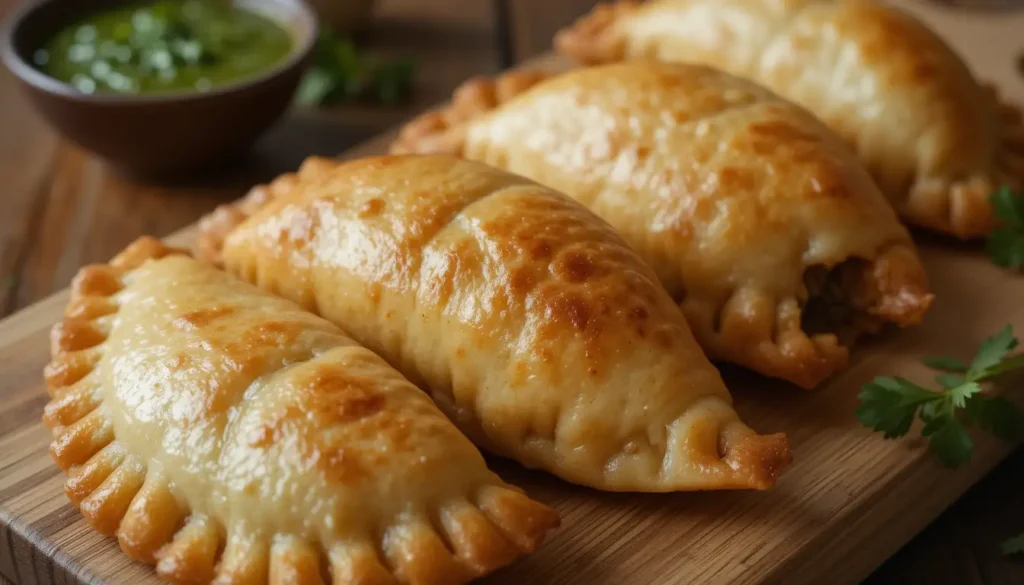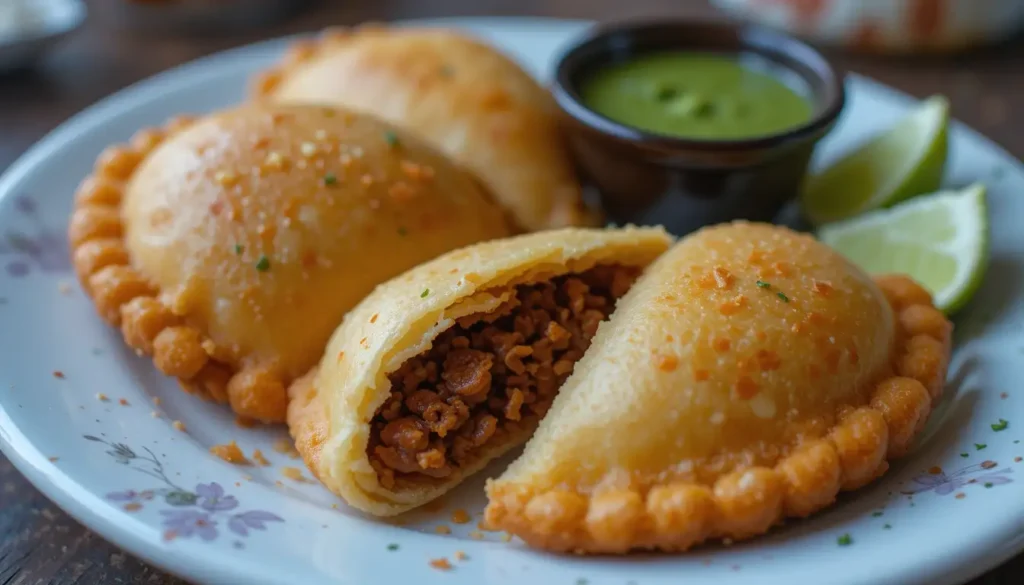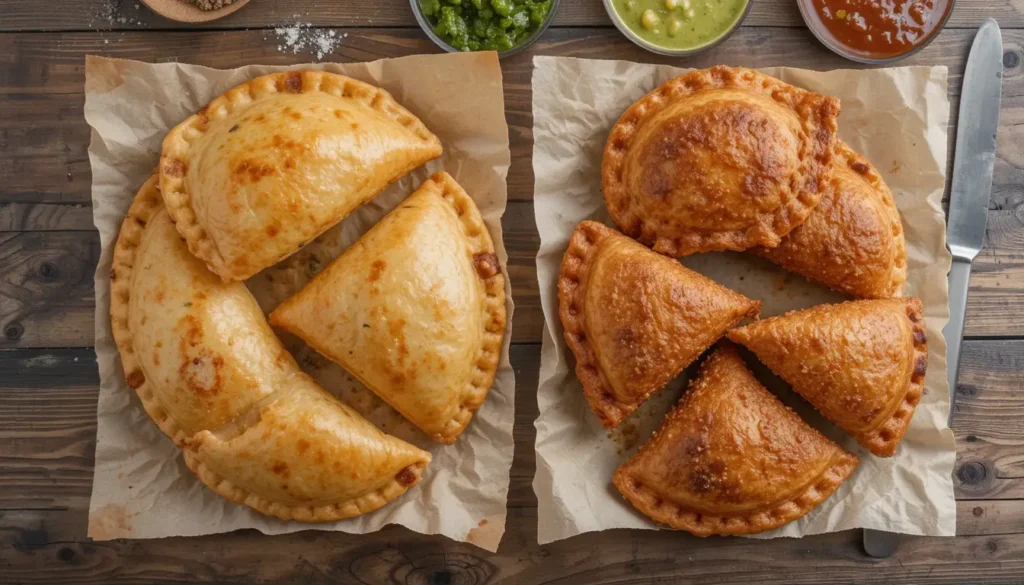Empanadas are more than just food—they are pieces of tradition wrapped in dough and bursting with flavor. Whether you’re in Buenos Aires or Caracas, these handheld delights play a key role in Latin American culture. But the question arises: what is the difference between Argentina and Venezuela empanadas? On the surface, they might look similar, but each country puts its unique spin on these beloved pastries. From the ingredients to the cooking methods, regional flavors tell their own stories.
In this article, we’ll dive into the intriguing world of Argentine and Venezuelan empanadas. You’ll discover how the two differ, learn about their origins, ingredients, and preparation styles, and pick up some tips for making perfect empanadas at home.
Table of Contents
The Origins of Empanadas in Latin America
Empanadas have deep roots that stretch far beyond Latin America. While today they’re a staple in places like Argentina and Venezuela, their history can be traced back to Spain and Portugal. During the Moorish occupation of the Iberian Peninsula, Middle Eastern cooking techniques—like filling dough with spiced meat—found their way into Spanish kitchens.
Spanish colonizers later brought empanadas to Latin America, where the dish evolved based on local ingredients and tastes. The empanada quickly became a culinary canvas, allowing cooks to get creative with fillings, spices, and cooking methods.
In Argentina, empanadas became popular among gauchos (cowboys), who carried these hearty pockets of food while working on the pampas. Meanwhile, Venezuela’s coastal influence introduced Caribbean flavors, giving their empanadas a distinct tropical flair.
Today, empanadas are a point of pride in both countries—so much so that comparing the two is like debating football teams.
If you are an Empanadas lover check this Article about Spanish and Mexican empanadas
What Sets Argentina and Venezuela Empanadas Apart?
At first glance, an Argentine empanada and a Venezuelan empanada might look identical. Both are stuffed pastries, after all. However, a closer look (and taste) reveals significant differences. These variations arise from the dough, the fillings, and the preparation methods.
Let’s break it down step by step:
Key Differences in Dough Preparation

The dough is where the magic begins, and this is one of the biggest areas where Argentina and Venezuela diverge.
Argentine Dough
In Argentina, empanada dough is often light, flaky, and tender. It’s typically made with wheat flour, water, salt, and either lard or butter. The dough’s elasticity allows it to be rolled thin, which results in a soft, melt-in-your-mouth texture when baked.
Interestingly, Argentines bake their empanadas more often than they fry them. This method gives the pastry a golden, slightly crisp exterior while keeping it tender and light inside.
Venezuelan Dough
On the other hand, Venezuelan empanada dough has a more robust, hearty texture. It’s often made using cornmeal instead of wheat flour, which gives the dough a thicker, crunchier consistency. If you’ve ever eaten an arepa (another Venezuelan staple), the corn-based dough will feel familiar.
Venezuelan empanadas are usually fried, not baked. This frying process creates a golden-brown, crispy crust that contrasts beautifully with the soft fillings.
The Verdict?
If you prefer something light and flaky, Argentine empanadas are your go-to. But if you crave crunch and bold texture, Venezuelan empanadas will win your heart.
Varieties of Fillings: Meat, Cheese, and More

Filling is the soul of any empanada, and this is where regional flavors shine.
Argentine Fillings
Argentine empanadas are known for their savory, subtle flavors. The most iconic filling is empanada de carne, made with finely chopped or ground beef, onions, and mild spices. In some regions, you’ll also find boiled eggs, olives, and raisins added to the mix.
Regional variations abound:
- In Salta, empanadas have a slightly spicier beef filling.
- Tucumán’s empanadas are juicier, often incorporating potatoes.
- In Buenos Aires, cheese and ham fillings are popular among younger crowds.
Seafood lovers can also find empanadas filled with tuna, shrimp, or cod in coastal regions.
Venezuelan Fillings
Venezuelan empanadas, on the other hand, pack a bolder punch. Thanks to the country’s Caribbean influence, the fillings often include rich, tropical ingredients.
The most popular options include:
- Pabellón Criollo: A filling inspired by Venezuela’s national dish—shredded beef, black beans, plantains, and cheese.
- Queso Blanco: A simple yet delicious filling of salty white cheese that melts perfectly when fried.
- Cazón: A traditional coastal filling made from shark meat cooked with spices.
You’ll also find combinations like chicken with avocado or cheese with sweet plantains—showcasing Venezuela’s love for sweet-savory blends.
The Flavor Showdown
While Argentine empanadas emphasize balance and subtlety, Venezuelan empanadas are all about bold, tropical flavors.
Cooking Methods: Baked vs. Fried Empanadas

The final step in the empanada-making process is cooking, and here’s where the two countries take completely different routes.
Baked Argentine Empanadas
In Argentina, most empanadas are baked (al horno). This method creates a golden-brown crust with a tender texture. Baking allows the flavors of the filling to shine without being overpowered by oil.
Baking also makes Argentine empanadas a little healthier—if you’re counting calories!
Fried Venezuelan Empanadas
Venezuelan empanadas, on the other hand, are almost always fried. The cornmeal dough fries beautifully, creating a crispy, golden exterior that’s downright addictive.
The frying process also enhances the bold flavors of the fillings, giving Venezuelan empanadas their signature taste and texture.
Which Method Wins?
If you prefer something light and refined, baked Argentine empanadas are perfect. But if you’re in the mood for indulgence, a crispy, fried Venezuelan empanada is pure bliss.
The Role of Regional Culture in Empanada Recipes
Empanadas reflect the cultural diversity of the regions they come from. Argentina’s empanadas are shaped by European traditions, while Venezuela’s empanadas carry strong Caribbean and indigenous influences.
Empanadas in Argentina: A Regional Breakdown
Argentine empanadas vary significantly depending on where you are in the country. For example:
- Northern regions like Salta and Tucumán add bold spices and potatoes.
- Patagonia incorporates lamb or seafood into their fillings.
- Buenos Aires tends to favor milder flavors and modern takes.
Venezuela Empanadas: Coastal Influence and Ingredients
Venezuela’s empanadas often feature seafood and tropical ingredients. Coastal regions use fish like cazón, while inland areas experiment with plantains and beans. This variety reflects the country’s rich agricultural and cultural heritage.
Ingredients: Argentina vs. Venezuela Empanadas

When it comes to empanadas, ingredients are everything. They shape the flavor, texture, and overall experience of the dish. While both Argentina and Venezuela share a passion for crafting delicious empanadas, the ingredients they use set them apart in truly unique ways.
Traditional Argentine Empanada Ingredients
In Argentina, empanada ingredients reflect European culinary influence combined with local flair. The dough, typically made with wheat flour, is smooth, tender, and pliable—ideal for creating the perfect pastry pockets. Butter or lard provides a rich flavor and ensures the dough has a soft, flaky texture when baked.
The fillings are where Argentine empanadas shine:
- Beef: Beef is king in Argentina. Empanadas de carne (meat empanadas) are made with finely chopped or ground beef, onions, and sometimes bell peppers. A light touch of cumin, paprika, and salt adds subtle depth to the flavor.
- Eggs and Olives: Hard-boiled eggs and green olives are often added to the filling for a savory twist, particularly in the Tucumán and Salta regions.
- Cheese and Ham: Cheese, especially mozzarella or provolone, is a popular filling when paired with ham. This combination is beloved across the country.
- Seafood: In coastal areas, seafood like tuna or shrimp makes an appearance in empanadas, offering a fresh, briny taste.
Argentine cooks prefer subtle seasoning, allowing the natural flavors of the ingredients to take center stage.
Core Ingredients in Venezuelan Empanadas
Venezuelan empanadas, on the other hand, are bolder in both ingredients and flavor. The dough is made using cornmeal, which creates a heartier, chewier, and slightly grainy texture. The corn-based dough not only gives the empanada its unique crunch but also complements the fillings beautifully.
The most common fillings include:
- Pabellón Criollo: Inspired by Venezuela’s national dish, this filling includes shredded beef, black beans, sweet plantains, and salty white cheese. It’s a vibrant, flavor-packed combination.
- Queso Blanco: Venezuelans love cheese empanadas, particularly those stuffed with queso blanco—a soft, salty white cheese that melts perfectly when fried.
- Cazón: In coastal areas, shark meat (cazón) is a popular filling. It’s seasoned with garlic, onion, and peppers for a rich, savory taste.
- Chicken and Avocado: Shredded chicken paired with avocado and sometimes a splash of lime juice offers a creamy, tangy flavor.
- Plantains: Sweet plantains, either alone or paired with cheese, are another tropical favorite in Venezuelan empanadas.
The boldness of Venezuelan ingredients reflects the country’s Caribbean influence, with sweet and savory flavors often mingling in delicious harmony.
Presentation and Serving Styles

Once cooked, empanadas from Argentina and Venezuela are presented and served in distinct ways, reflecting each country’s culinary style and traditions.
Argentine Empanadas
In Argentina, empanadas are often served warm and plated elegantly, particularly in formal settings. Baked empanadas tend to have a light golden crust that looks inviting. Each region also has its own method of crimping or sealing the empanadas, known as repulgues. These intricate patterns not only look beautiful but also indicate the type of filling inside.
Argentine empanadas are typically enjoyed with a light dipping sauce like chimichurri. This herby, garlicky sauce made with parsley, olive oil, vinegar, and a hint of spice adds a refreshing kick that enhances the flavors of the filling.
Venezuelan Empanadas
In Venezuela, empanadas are far more casual and rustic. Fried to a golden-brown crisp, they’re often sold as street food and served in paper wrappers or small baskets. Unlike Argentine empanadas, Venezuelan empanadas don’t usually have decorative crimping—they’re all about practicality and flavor.
To elevate their taste, Venezuelans often serve empanadas with dipping sauces like:
- Guasacaca: A creamy avocado-based sauce similar to guacamole but with vinegar for added tanginess.
- Salsa Rosada: A simple yet delicious mix of mayonnaise and ketchup, perfect for pairing with crispy fried empanadas.
Venezuelan empanadas are hearty and satisfying, making them a popular breakfast or on-the-go snack.
Taste Experience: Comparing Texture and Aroma
When you bite into an empanada, you experience more than just the filling—you’re tasting the love and culture that went into crafting it. Both Argentine and Venezuelan empanadas offer unique textural and aromatic experiences.
Argentina Empanadas: Soft and Savory
Argentine empanadas offer a delicate texture that’s hard to resist. The baked dough is soft, light, and slightly flaky, creating a gentle contrast with the savory filling. This makes each bite a balanced and cohesive experience, where no single ingredient overpowers the others.
The aroma of Argentine empanadas is subtle and comforting, with warm notes of cumin, paprika, and the natural sweetness of sautéed onions. You might even smell the buttery richness of the dough as it bakes—a smell that’s guaranteed to make your mouth water.
Venezuela Empanadas: Crunchy and Flavorful
Venezuelan empanadas are a completely different experience. The crispy, cornmeal-based dough delivers a satisfying crunch with every bite, making them feel hearty and indulgent. The fried exterior locks in the bold, flavorful fillings, which often include combinations of salty, sweet, and savory tastes.
When it comes to aroma, Venezuelan empanadas have a stronger presence. You’ll catch the scent of frying cornmeal, combined with the rich spices and ingredients inside. It’s an irresistible combination that speaks to the heart of Venezuelan cooking.
Common Problems When Making Empanadas
Whether you’re a novice cook or an experienced chef, making empanadas at home can sometimes be tricky. Both Argentine and Venezuelan styles come with their own challenges. Here are some common issues you might encounter:
Dough Problems
- Dry Dough: If your dough is cracking or too dry, it’s often because it doesn’t have enough fat or moisture.
- Sticky Dough: On the flip side, dough that’s too sticky can be hard to work with, especially for Venezuelan cornmeal dough.
Filling Issues
- Soggy Fillings: Too much moisture in your filling can cause the empanadas to become soggy, particularly when baked.
- Underseasoned Fillings: If your filling lacks flavor, the empanada won’t deliver the delicious experience you’re aiming for.
Cooking Challenges
- Uneven Cooking: Whether baking or frying, uneven heat can cause some parts of the empanada to cook faster than others.
- Leaking Fillings: Overstuffing the dough can cause the filling to spill out during cooking, making a mess and impacting presentation.
Solutions and Tips for Perfect Empanadas
Now that you know the common problems, let’s talk about solutions!
Dough Tips
- For Argentine empanadas, add a little more fat (butter or lard) to achieve a flaky texture. Let the dough rest for at least 30 minutes to make it easier to roll out.
- For Venezuelan empanadas, use lukewarm water when mixing cornmeal dough. This helps keep the consistency smooth and manageable.
Filling Tips
- To prevent soggy fillings, cook the meat or vegetables beforehand to reduce excess moisture. Allow the filling to cool before stuffing the dough.
- Taste your filling as you cook to ensure it’s properly seasoned. A pinch of cumin, paprika, or garlic can go a long way!
Cooking Tips
- Bake Argentine empanadas at a consistent temperature of 375°F to ensure even browning. Brush the tops with an egg wash for a shiny, golden crust.
- For Venezuelan empanadas, heat oil to 350°F and fry in small batches to maintain the perfect crispiness.
Empanada Popularity: Global Appeal and Adaptations
While empanadas are a culinary staple in Argentina and Venezuela, their popularity has spread far beyond Latin America. From street food stalls in Spain to food festivals in New York, these delicious pastries have found their place on menus around the globe. But what makes empanadas so universally loved?
Empanadas are versatile. They can be stuffed with virtually any filling—meat, vegetables, cheese, or even sweet ingredients—making them adaptable to local tastes. This flexibility has allowed chefs and home cooks worldwide to create their own interpretations of these handheld delights.
Argentine Empanadas Abroad
Argentine-style empanadas have found a home in many international markets, especially in places with a significant Argentine diaspora, like Spain, Italy, and the United States. In cities like New York and Los Angeles, upscale Argentine restaurants often serve baked empanadas alongside a glass of Malbec, Argentina’s signature red wine.
The simplicity of Argentine empanadas makes them easy to adapt without losing their essence. Variations like spicy beef, spinach and ricotta, and mushroom fillings have gained traction, appealing to a wider audience.
Venezuelan Empanadas Abroad
Venezuelan empanadas, on the other hand, bring bold and tropical flavors to the table. They’ve gained popularity in regions with a strong Latin American presence, such as Florida and Texas. Food trucks serving crispy Venezuelan empanadas with dips like guasacaca have become local favorites.
The use of cornmeal dough in Venezuelan empanadas sets them apart from their wheat-based cousins, giving them a unique appeal to gluten-free food enthusiasts. Additionally, tropical fillings like plantains, black beans, and shredded chicken cater to adventurous eaters looking to explore new flavors.
A Global Fusion
Modern chefs have taken the concept of empanadas and added their own cultural twist. You’ll find Korean-inspired empanadas stuffed with bulgogi beef, Indian empanadas filled with curried potatoes, and even dessert empanadas with chocolate, bananas, or caramelized apples.
This global appeal highlights the beauty of empanadas: they are timeless, adaptable, and always satisfying. Whether baked, fried, savory, or sweet, there’s an empanada for everyone.
FAQs: Understanding Argentina and Venezuela Empanadas
What makes Argentine empanadas unique?
Argentine empanadas are unique because of their tender, flaky dough and subtle, savory fillings. They are typically baked instead of fried, which gives them a light texture. Fillings often include beef, chicken, ham and cheese, or vegetables.
Why are Venezuelan empanadas made with cornmeal?
Venezuelan empanadas are made with cornmeal because corn is a staple ingredient in Venezuelan cuisine, influenced by indigenous traditions. The cornmeal dough creates a heartier texture and a delicious crunch when fried.
Are Argentine or Venezuelan empanadas healthier?
Argentine empanadas are often considered healthier because they are baked rather than fried, resulting in less oil and fewer calories. However, both types can be enjoyed in moderation as part of a balanced diet.
What is the most popular filling in Argentine empanadas?
The most popular filling in Argentine empanadas is empanada de carne, which features finely chopped or ground beef cooked with onions, spices, and sometimes hard-boiled eggs and olives.
How do you make Venezuelan empanadas crispy?
To achieve crispy Venezuelan empanadas, the key is frying the cornmeal dough in hot oil at the right temperature (around 350°F). Frying in small batches ensures even cooking and that golden, crunchy texture.
Can I freeze empanadas to cook later?
Yes, both Argentine and Venezuelan empanadas can be frozen. Assemble the empanadas, place them on a tray to freeze individually, and then store them in an airtight container. For Argentine empanadas, bake from frozen. For Venezuelan empanadas, fry straight from the freezer for best results.
Argentina vs. Venezuela Empanadas
So, what is the difference between Argentina and Venezuela empanadas? It all comes down to tradition, culture, and flavor. Argentina’s empanadas are light, flaky, and elegant, often baked to perfection with subtle, savory fillings. On the other hand, Venezuela’s empanadas are hearty, crispy, and bold, fried to golden perfection with fillings that embrace tropical and Caribbean influences.
Both versions have earned their place as iconic culinary treasures, and choosing between them is simply a matter of preference. If you love delicate textures and balanced flavors, Argentine empanadas will win you over. But if you crave crunch, boldness, and hearty fillings, Venezuelan empanadas are calling your name.
Ultimately, both types of empanadas reflect the cultural richness and culinary creativity of their respective countries. Whether you’re enjoying a baked empanada in Buenos Aires or savoring a crispy fried one in Caracas, you’re experiencing a little piece of history wrapped in dough.
Final Thoughts
Empanadas are more than just a snack—they’re a celebration of culture, tradition, and flavor. Whether you prefer the baked, flaky empanadas of Argentina or the crispy, fried delights of Venezuela, there’s no denying the magic that these handheld pastries bring to the table.
The next time you find yourself pondering what is the difference between Argentina and Venezuela empanadas, remember that both styles offer a unique culinary experience worth savoring. So why not try making both at home? After all, food is about exploration, connection, and joy—and empanadas are the perfect way to experience all three.

